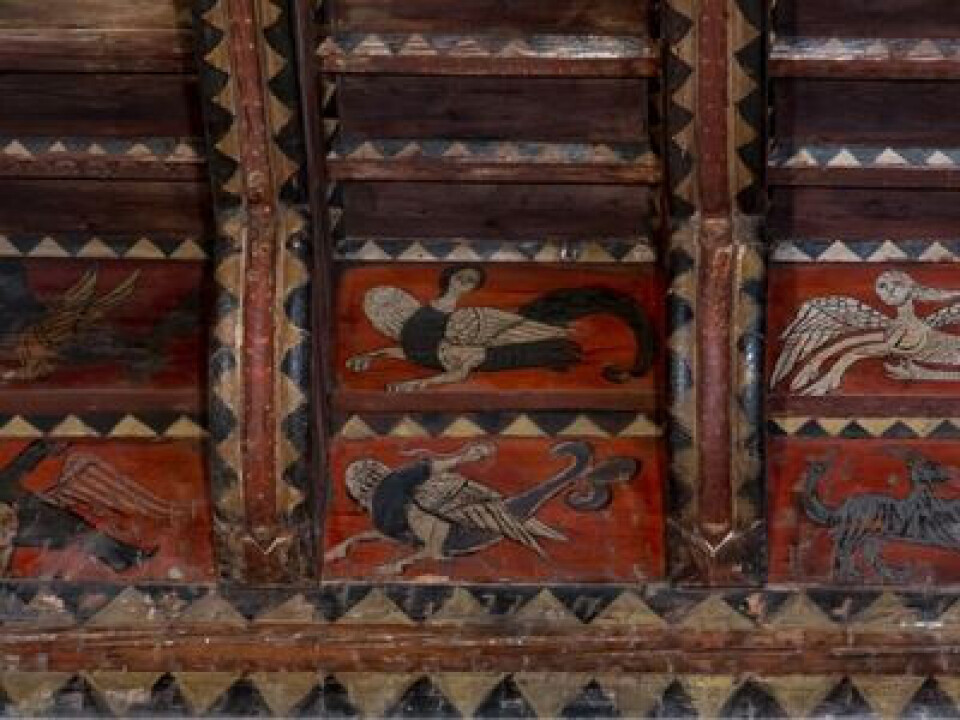-
Step back in time for some ‘dinosaur’ planting in your French garden
Captivated in the garden this month by one species of plant that dates back 200 million years, and another which is one of the oldest flowering plant families on the planet
-
Classic French recipe with an exotic twist: caramelised onion soup
A dish inspired by the travels of two Paris chefs
-
HPI final season: the end of a French TV phenomenon
Comedy-thriller starring Audrey Fleurot that gripped France airs final episodes
Find medieval knights and monsters painted on Narbonne palace ceiling
We tell you where to look for 13th-century images of gruesome violence and imaginary creatures in the corners of this holy place

From the outside, the east wing of the old archbishops’ palace in Narbonne looks like any other imposing monumental medieval edifice.
Go inside, however, and a spellbinding medieval world of monsters and battles awaits.
On the first floor, a painted ceiling made in the second half of the 1210s, transports you to a place populated by real and imaginary creatures, monsters, soldiers and fair maidens.
Read more: Film 'The Last Duel': Do you recognise these French locations?
Crusading archbishop commissioned lavish decoration
The ceiling was painted when a certain Arnaud Amalric was archbishop of Narbonne, a man more famous for the role he played in the bloody Albigensian Crusade against the Cathars in the Midi than for the beauty of the buildings he commissioned.
It was this archbishop who ordered the infamous massacre at Béziers, and which, he admitted in a letter to Pope Innocent III in 1209, resulted in the slaughter of nearly 20,000 people.
Yet Amalric was clearly just as fired up by making a palace fit for a prince (of the Church) as he was by overseeing the extermination of heretics in the name of God.
The ceiling tops a large room called an aula, which served as the archbishop’s principal room.
This is where Amalric conducted business, received visitors and hosted lavish dinners.
Read more: Discover medieval underground cave churches in Nouvelle-Aquitaine
Room is flashback to nearly 1000 years ago
Visitors entering the room were greeted not only by spectacular painted scenes above them but, in all probability, around them, too.
The wall paintings have long since disappeared, but the ceiling, miraculously, still retains its medieval decoration.
What the visitor looks at now represents a precious flashback to the people who talked, ate and walked in this room nearly a thousand years ago; a chilling prospect when you consider that these delightful paintings were ordered and paid for by a man responsible for so many thousands of deaths.
What you will see if you look up
Amalric’s painted ceiling is made up of 33 wooden beams laid out between the east and west walls.
Between the brackets and the beams, around the top of the walls on both sides, are 126 closoirs, small wooden panels bearing an array of fantastical beasts, birds, heroes and heroines.

126 ‘closoirs’ or small painted wooden panels; Photo: Catherine Lauthelin, Ville de Narbonne
The painted beams and the joists, visible from anywhere in the room, are bedecked with graceful vegetal and floral motifs. Nothing to raise the blood pressure here.
But tucked away in the shadows are scenes of derring-do and chivalry guaranteed to tantalise and inspire.
Panels show beasts and violence
Unfortunately, not all the individual panels retain their original images.
In the 1950s, restorers from a Parisian workshop saw fit to touch up 56 out of the 126 panels in their own distinct style, which painted medieval ceiling specialists Georges Puchal and Julien Foltran describe as maladroite.
There are no religious figures or bible stories on display, despite the patron’s lofty ecclesiastical status and the ceiling’s location in the archbishops’ palace.
These paintings were, on the contrary, designed to convey the delights of the profane rather than the sacred world.
Birds, animals and a mix-and-match combination of the two, chew the scenery with man-and-beast hybrids, and even an elephant carrying a tower on its back.
In one narrative of particularly graphic violence, one soldier slices off another’s leg at the knee with his sword.
Elsewhere, a knight tumbles to his death from the castle battlements.
The images’ immediacy transcends the centuries that separate the artists from the modern viewer.
Whitewashed scenes are rediscovered
No matter how enchanting we find these snapshots of medieval life today, ceilings painted with lively, colourful narratives fell out of fashion in the sixteenth century.
Many were covered over with bucolic and mythological scenes in muted colours, or simply whitewashed over.
In the old archbishops’ palace in Narbonne, for example, the medieval painted panels were rediscovered at the end of WW2 beneath a false ceiling when the Musée archéologique was being installed in the building.
Before the museum claimed the space, this part of the old palace had served as a prison in the nineteenth century, and as a school after that, their inhabitants unaware of the painted treasures concealed above them.
And these marvels of medieval artistry are still being found.
Last winter, an architect working on a renovation project in Montpellier uncovered remnants of a painted medieval ceiling in someone’s house, in which an angel appears to burst forth from the top of a chimney.
You just never know what’s hiding beneath those layers of whitewash.
Related articles
Two saints buried in one tomb still draws pilgrims to French priory
Art: France’s long history of copying Old Masters at the Louvre
Biennale de Lyon art fair now one of France’s key cultural events
























